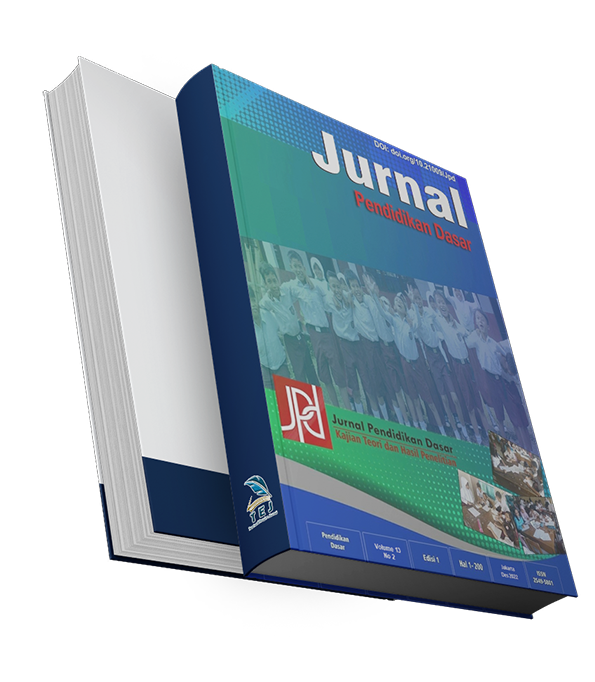ANALISIS KEBUTUHAN PENGEMBANGAN E-HANDOUT MATERI PROSES FOTOSINTESIS PADA TUMBUHAN BERBASIS PROJECT BASED LEARNING UNTUK MENINGKATKAN HASIL BELAJAR SISWA KELAS IV SDN BURENGAN 2
DOI:
https://doi.org/10.21009/jpd.v15i1.44941Keywords:
analisis kebutuhan, e-handout, proses fotosintesis pada tumbuhan, kelas 4, SDN Burengan 2Abstract
Abstract: Needs analysis is the initial stage used to determine the problems that exist in learning in a school. The purpose of this study was to obtain information about the needs analysis of e-handout teaching materials on photosynthesis process material in plants in class IV SDN Burengan 2. The method used in this research is descriptive and uses quantitative scores or analysis. The subjects of this study consisted of principals, teachers, and fourth grade students of SDN Burengan 2 Kediri City. Data collection was carried out using interviews, questionnaires, and observation techniques. The problems in this study are the lack of reading related to the material, lack of student understanding of the process of photosynthesis in plants, a total of 30 out of 56 students still get scores below the KKTP (Criteria for Achieving Learning Objectives), the lack of teaching materials used, and the lack of project activities on the material of the photosynthesis process in plants. Based on the results of the needs analysis, it can be concluded that the development of e-handout material on the process of photosynthesis in plants based on project-based learning is needed to improve the learning outcomes of fourth grade students of SDN Burengan 2. This research can be developed to the e-handout development stage for maximum results.
Keywords: needs analysis, e-handout, photosynthesis process in plants, 4th grade, SDN Burengan 2
References
Gayatri, G., Rusadi, U., Meiningsih, S., Mahmudah, D., Sari, D., & Nugroho, A. C. (2015). Perlindungan Pengguna Media Digital Di Kalangan Anak Dan Remaja Di Indonesia. Jurnal Penelitian Dan Pengembangan Komunikasi DanInformatika, 6(1), 1–18.
Hanafy, M. S. (2014). Konsep Belajar Dan Pembelajaran. Lentera Pendidikan : Jurnal Ilmu Tarbiyah Dan Keguruan, 17(1), 66–79. https://doi.org/10.24252/lp.2014v17n1a5
Heriyansyah, H. (2018). Guru Adalah Manajer Sesungguhnya Di Sekolah. Islamic Management: Jurnal Manajemen Pendidikan Islam, 1(01).
Ismail, I. (2019). GURU KREATIF; Suatu Tinjauan Teoritis. Al-Qalam: Jurnal Kajian Islam Dan Pendidikan, 11(2), 15–30. https://doi.org/10.47435/al-qalam.v11i2.425
Kurnia, I., Noviantiningtyas, T., & Rohmania, Q. N. (2021). Game Hago Sebagai Media Pembelajaran Di Sekolah Dasar. Jurnal Pendidikan Dasar Nusantara, 7(1), 119-129.
Pristiwanti, D., Badariah, B., Hidayat, S., & Dewi, R. S. (2022). Pengertian pendidikan. Jurnal Pendidikan Dan Konseling (JPDK), 4(6), 7911-7915.
Sahidu, H., Gunawan, G., Rokhmat, J., & Rahayu, S. (2018). Pengembangan Perangkat Pembelajaran Fisika Berorientasi Pada Kreativitas Calon Guru. Jurnal Pendidikan Fisika dan Teknologi, 4(1), 1-6.
Tambunan, S. A. (2021). Analisa Kebutuhan Pengembangan Media Pembelajaran Pada Mata Pelajaran Konstruksi Dan Utilitas Gedung Di Kelas Desain Permodelan Dan Informasi Bangunan Smk Negeri 1 Percut Sei Tuan. Jurnal Pendidikan Teknik Sipil, 3(1), 23-27.
Primasatya, N., & Mukmin, B. A. (2020). Validitas multimedia interaktif K13 pada materi pecahan sebagai inovasi pembelajaran tematik bagi siswa Kelas IV. Jurnal Math Educator Nusantara (JMEN), 6(1), 84-93., 5–24.
Downloads
Published
How to Cite
Issue
Section
License

This work is licensed under a Creative Commons Attribution 4.0 International License.
Jurnal Pendidikan Dasar





















